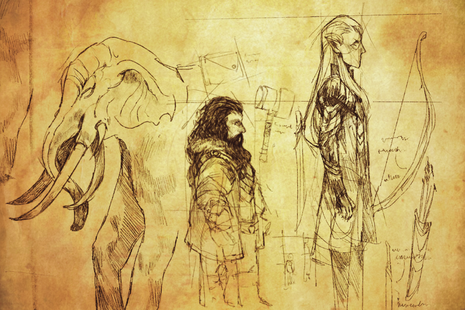The Elvish gene?
Maya Kunchur looks at the world of Lord of the Rings from the perspective of an evolutionary biologist

I recently watched the Lord of the Rings trilogy, and thoroughly enjoyed it. However, when I put my scientist hat on, several aspects of the fantasy world suddenly looked a lot less plausible, and it might not be for the reasons you expect. That being said, flora and fauna have undergone constant change before constructing the biodiverse ecosystems we recognise today, and several features of Middle Earth are surprisingly close to the Earth our ancestors walked.
Of course, this is a bit of fun: half the point of fantasy is to forget reality and immerse yourself in a magical world. I appreciate that, but it’s interesting why a few aspects of Middle Earth are scientifically fantasy to us but were actually more realistic in ancient times.
The Oliphants
In a world where eagles can converse with humans and cave trolls are a legitimate threat, a giant elephant doesn’t seem like that much of a stretch. An elephant could just keep growing until it’s three stories high, right? Except scaling doesn’t work like that. With such a vast increase in body mass for the same anatomy, the surface area to volume ratio becomes hugely skewed. Physiological characteristics like sweat production, having legs thick enough to support its own weight and blood pooling due to pressure changes would quickly become big problems.
“Though the coexistence of multiple intelligent species seems quintessentially Middle Earth, it’s actually not so far from the life our ancestors lived”
But you might have heard about giant ancestors to extant organisms, like massive dragonflies (Meganeura) or two-metre-long millipedes (Arthropleura), and query how this was possible. In this era of megafauna, atmospheric oxygen concentration was higher than today, so the rate of oxygen uptake by diffusion was greater. As organism populations grew, the oxygen uptake for aerobic respiration led to changes in the relative concentrations of atmospheric gases. The upper physiological limit on insect body size has therefore decreased over time. Other megafauna such as the giant sloth unfortunately likely went extinct due to hunting.
Mixing populations of species
Maybe it’s because I’m reading Jonathan Kennedy’s Pathogenesis, but as I watched elves, dwarves, humans and various other creatures greet each other and mingle in large populations I wondered about the spread of disease.
Though the coexistence of multiple intelligent species seems quintessentially Middle Earth, it’s actually not so far from the life our ancestors lived. Homo sapiens inhabited Earth at the same time as other types of humans such as neanderthalensis. There were no dwarves, but Homo floresiensis from the Indonesian Island Flores were only 1 metre tall. Much like Middle Earth, different populations kept to themselves, but this time for thousands of years. When they did meet, war was perhaps not fought with swords but with pathogens; it’s believed diseases spread by Sapiens played a significant role in extinction of Neanderthals. Having lived longer in the hotter, tropical African climate, Sapiens likely adapted immunity to a wider range of diseases over time. When they spread upwards into Europe and met the Neanderthals, both populations would have suffered from alien diseases spread by the other, but Neanderthals may have suffered worse for this reason.
“So, to conclude: your great-great-great….-great grandma was definitely not the elf Lady Galadriel, but she might have been a Neanderthal”
Are elves and humans actually the same species?
Several characters in Middle Earth are the product of interbreeding between the multiple intelligent species. There’s just one problem with this: it worked. Classically, a species is defined as members of a group which can freely interbreed to produce fertile offspring. So if Aragorn is only half human, perhaps elves and humans are not distinct species?
Once again, there are parallels to our world. Homo sapiens and Homo neanderthalensis are widely considered separate species, but modern humans have between 1 and 4% Neanderthal DNA and many of us possess Denisovan genes. Clearly, successful crossbreeding occurred without ending the family line. This is one of many examples that make it so difficult to impose a singular species definition.
So, to conclude: your great-great-great….-great grandma was definitely not the elf Lady Galadriel, but she might have been a Neanderthal. Instead of riding a giant elephant, let’s imagine she once saw a giant sloth. Next time you read a fantasy book, enjoy pondering what else she could have plausibly experienced: hopefully it makes you appreciate how our home planet has its own magical qualities.
 News / Eight Cambridge researchers awarded €17m in ERC research grants27 December 2025
News / Eight Cambridge researchers awarded €17m in ERC research grants27 December 2025 News / Downing investigates ‘mysterious’ underground burial vault 29 December 2025
News / Downing investigates ‘mysterious’ underground burial vault 29 December 2025 Lifestyle / Ask Auntie Alice29 December 2025
Lifestyle / Ask Auntie Alice29 December 2025 Sport / Hard work, heartbreak and hope: international gymnast Maddie Marshall’s journey 29 December 2025
Sport / Hard work, heartbreak and hope: international gymnast Maddie Marshall’s journey 29 December 2025 News / News in Brief: carols, card games, and canine calamities28 December 2025
News / News in Brief: carols, card games, and canine calamities28 December 2025







